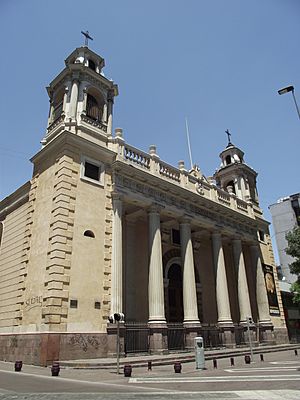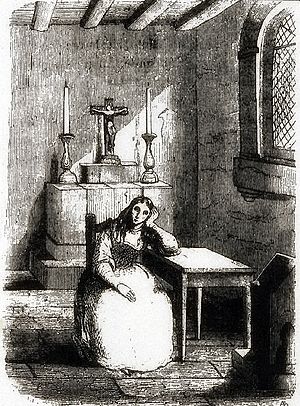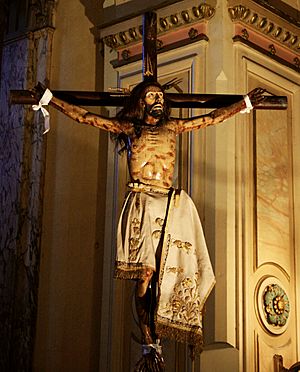Quintrala facts for kids
Catalina de los Ríos y Lísperguer (born around 1604 – died January 16, 1665) was a wealthy landowner in Chile during the 1600s. People called her La Quintrala because her bright red hair looked like the red flowers of a plant called quintrala. She was known for her beauty and, according to stories, for being very strict with the people who worked for her. In Chilean culture, she is remembered as a powerful and sometimes feared woman.
Contents
Her Early Life
Catalina was born into a rich and important family in Chile. Her parents were Gonzalo de los Ríos y Encío and Catalina Lisperguer y Flores. Both families were well-known in Santiago.
Her father, Gonzalo, was a soldier who fought in the Conquest of Chile. He owned many large farms where sugar cane, fruit trees, and grapes were grown. Enslaved people worked on these farms. He also served as the mayor of Santiago several times.
Catalina and her sister, María, were the only girls among eight children.
Growing Up
Catalina grew up in a very wealthy family. Even though her family was rich, she did not get a good education and could barely read or write. Her father and grandmother mostly took care of her.
Her nickname, "La Quintrala," might have come from a shorter version of her name, like Catrala. Another idea is that it came from the quintral plant. Some say she used branches from this plant to whip her workers. The plant's red flowers matched her red hair.
People thought Catalina was very beautiful. She had fair skin, was tall, and had red hair and bright green eyes. Her family background, a mix of Native American, Spanish, and German heritage, gave her striking looks.
When she was about 18, in 1622, there were rumors that she had harmed her own father when he was sick. Even though her aunt told the authorities, Catalina was never punished. This might have been because there wasn't enough proof or because her family was very powerful.
Her Adult Life
Marriage
After Catalina's parents passed away, her grandmother, Águeda Flores, became her guardian. Águeda wanted Catalina to get married, hoping it would help her change her ways. She offered a large dowry (a gift of money or property given by the bride's family to the groom or his family) of 45,349 pesos, which was a lot of money back then.
In September 1626, when she was 22, Catalina married Alonso Campofrío de Carvajal y Riberos. He was a 42-year-old Spanish colonel from a noble family.
Alonso quickly gained important public positions. The year after they married, Catalina had her only child, a son named Gonzalo. He died when he was young, between 8 and 10 years old. Around 1628, Catalina's sister died, and Catalina inherited much of her sister's land in Chile.
Historians say that Catalina's husband knew about her strict ways. However, he was kind to her, and she respected him, even if she didn't love him.
As a Landowner
Catalina inherited a lot of land from her father, becoming a very wealthy landowner. She owned farms in different parts of Chile and even beyond the Andes mountains. She lived on one of her estates near Santiago, where she enjoyed riding her horses. She preferred country life to the city.
Catalina was known for being very harsh. One year, her workers ran away to the mountains because of her cruelty. Catalina used the law to force them back. Her manager, Ascencio Erazo, brought them back to her estate. Catalina then oversaw their punishments, helped by her nephew, Jerónimo de Altamirano. Even with her cruel actions, she was not punished. This was because she shared her wealth with judges and lawyers, and she had many relatives in powerful positions.
Legal Troubles
In 1660, the Royal Audience (a high court in colonial times) started a secret investigation into the many complaints against La Quintrala. This was based on accusations from a bishop. Justice Francisco de Millán led the investigation.
The investigator found enough evidence to support the accusations. La Quintrala was arrested at her estate and taken to Santiago for a criminal trial.
Catalina was accused of many crimes against the people who worked for her. The trial was very slow because of her family's influence and her wealth. Even the judges seemed to favor her case. Because of this, the trial stopped, and Catalina was set free.
Many years later, justice tried to look into the accusations again. However, La Quintrala had already passed away nine years earlier.
Later Years and Death

In 1654, Catalina became a widow when her husband, Alonso, died. She then had full control over all her lands and businesses. In January 1662, a new trial against her began. That same year, her nephew Jerónimo died, and Catalina herself became ill. Her health slowly got worse until she died in 1665.
In her will and testament, written in 1665, Catalina paid for many religious services at the Church of San Agustin. These were for her own soul and the souls of her loved ones, as well as those who had worked for her. She also set up funds for charities. One of these was for the "Christ of May," a sculpture that, according to legend, belonged to her. She wanted an annual payment made on May 13th for this. She left smaller amounts of money to her relatives and friends. The rest of her wealth was sold off, with the money going to the Augustinian religious order.
Catalina died on January 15, 1665, at the age of 61. This was a very old age for that time. She was feared and talked about during her life, but she died alone and disliked by many. Her funeral was grand, and she was buried in the Church of San Augustín, as was the tradition for her family. However, the exact location of her tomb is unknown.
According to historical writings, much of her property was sold, and some of her farms were left empty for years. This was because people were afraid and believed bad things would happen if they had anything to do with La Quintrala.
Her Legacy
Catalina de los Ríos, or La Quintrala, is still a well-known figure in Chilean culture. She is often seen as a symbol of a powerful, sometimes harsh, woman. She also represents the strict rule of the Spanish Empire in Chile.
Today, writers are looking at La Quintrala's story in new ways. She was one of the few important female figures from 17th-century Chile.
A Danish composer named Lars Graugaard created an opera about her. His opera, La Quintrala, was first performed in Copenhagen in 2004.
Benjamín Vicuña Mackenna, a famous historian, wrote a book about her family called Los Lisperguer y La Quintrala in 1877.
See also
 In Spanish: La Quintrala para niños
In Spanish: La Quintrala para niños



